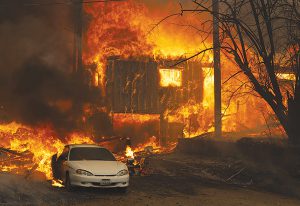Bloomberg
Already, 2022 is taking its place in a pantheon of years that have seen the nature of fire change — and all parts of the world fall under threat. It’s only expected to get worse, with drought and heat waves looming over the horizon for many parts of the globe.
At the epicenter of the fury will be the US West, where the decades-long megadrought has led to an “aridification,†according to Daniel Swain, a climatologist at the University of California, Los Angeles. So far this year, more than 24,000 fires have burned across the US, the highest in at least 10 years, National Interagency Fire Center data show.
That includes a fast-moving wildfire that ripped through a town in California’s Orange County in the past week, spurring nearly 1,000 evacuations and destroying homes in the wealthy enclave. In Colorado Springs, blazes killed a woman at a mobile-home park and forced the city’s airport to briefly close. Crews battled huge flames in Michigan.
The scariest part of all of this — it’s only May.
While living in the West has meant coming to terms in some ways with living in a danger zone, blazes are arriving earlier in the year and staying later.
Flames have scorched nearly 1.3 million acres across the country since January, reaching into places where they wouldn’t be expected to occur until months from now.
Just before the New Year in Colorado, a wildfire ripped through a suburban area, destroying more than 1,000 buildings. In California, Santa Ana wind season in October and November typically fuelled flames. Instead, there’s been burning all winter and spring, made worse by the drought,
Joe Tyler, director for California’s Department of Forestry and Fire Protection, commonly known as Cal Fire, said in a recent press conference.
“We are no longer in a fire season — we are in a fire year,†Tyler said.
On top of the most immediate threat to life, there’s likely to be profound devastation to homes and property, and with it, economic shock.
In an average year, flames can cause about $50 billion in damage globally, said Chuck Watson, a disaster modeler at Enki Research. But if even just one country has a bad year for fires, that total can easily rise to $200 billion or more. This year, it’s supposed to be bad in a lot of countries.
 The Gulf Time Newspaper One of the finest business newspapers in the UAE brought to you by our professional writers and editors.
The Gulf Time Newspaper One of the finest business newspapers in the UAE brought to you by our professional writers and editors.
